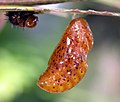Eumaeus atala
This article includes a list of general references, but it lacks sufficient corresponding inline citations. (December 2021) |
| Eumaeus atala | |
|---|---|

| |
| Scientific classification | |
| Domain: | Eukaryota |
| Kingdom: | Animalia |
| Phylum: | Arthropoda |
| Class: | Insecta |
| Order: | Lepidoptera |
| Family: | Lycaenidae |
| Genus: | Eumaeus |
| Species: | E. atala
|
| Binomial name | |
| Eumaeus atala (Poey, 1832)
| |

| |
| Range in Florida (Note: missing distribution in the Bahamas and Cuba) | |
Eumaeus atala, also known as the Atala butterfly or coontie hairstreak, is a small colorful butterfly in the family Lycaenidae. It is found in southeastern Florida (including the Florida Keys) in the United States, Cuba, the Bahamas, and the Cayman Islands in the West Indies. Its coloration and habits are unique among butterflies within its range.
History[edit]
The species was first described by the Cuban zoologist Felipe Poey. He named the butterfly for Atala, the Native American heroine of an 1801 French novella (Atala, ou Les Amours de deux sauvages dans le desert or in English: "Atala, or the Loves of two Indian savages in the desert") of the same name that was written by Chateaubriand.
Ecology[edit]
Throughout its range, the larvae feed on a native cycad, Zamia integrifolia (commonly called "coontie palm" or "arrowhead"), as well as Zamia pumila and other exotic ornamental cycads. In Cuba, the introduced cycad Cycas revoluta also is eaten by this species.
Adult butterflies take flower nectar and sometimes roost in trees. Adults fly through much of the year. The natural habitat is open brushy areas and tropical hammocks, often in pine woodlands. Many populations now exist in suburban areas containing ornamental cycads. Males keep close to a site with host plants, often forming small colonies of a few individuals. The females, however, may disperse in search of more hosts.
Description[edit]
The Atala butterfly is a great example of aposematic (warning) coloration throughout its life cycle. The brightly colored larva or caterpillar feeds on cycads that contain a toxic secondary plant chemical (cycasin) that it retains in its body for life. Birds, lizards, and other animals may attempt to prey on the larvae, pupae, and adults, but find them distasteful and learn to avoid these brightly patterned insects.
The butterfly's flight is slow, unlike the swift, erratic flight of many other Lycaenidae.
Breeding[edit]
Like many Lepidoptera, male atalas have hair-pencils (coremata) on their abdomens used in courtship; the male hovers in front of the female, wafting pheromones exuded from the pencils in her direction. Eggs are laid in clusters of 10-50 on the leaf tips of the host plant. Larvae feed on the leaves. Pupation is usually completed on the host plant.
Conservation[edit]
The United States population of the species was restricted to Florida and at one time, was believed to have become extirpated due to overharvesting of its host plant, the coontie palm. It was not collected in Florida from 1937 until 1959. In Palm Springs, Florida, the G-Star School of the Arts has been contributing to the growth of local population numbers.[2] The Atala butterfly is now extremely common locally in southeast Florida, having rebounded to the extent of almost being considered a pest for eating ornamental cycads planted in suburban areas as native plants are being chosen for landscaping.
Gallery[edit]
-
Adult resting on a leaf
-
Pupa
-
Larva
References[edit]
- ^ NatureServe. 2009. Eumaeus atala, Atala. NatureServe, Arlington, Virginia. Available https://explorer.natureserve.org/Taxon/ELEMENT_GLOBAL.2.109873/Eumaeus_atala. Accessed 10 November 2021.
- ^ Widom, Gary, "Butterfly close to extinction has been found at the G-Star School of the Arts", CBS12 News, Palm Springs, Florida, November 3, 2014, - archive link
- Jim P. Brock, Kenn Kaufman (2003). Butterflies of North America. Boston: Houghton Mifflin. ISBN 0-618-15312-8.
- Jeffrey Glassberg (1999). Butterflies through Binoculars: The East A Field Guide to the Butterflies of Eastern North America. New York: Oxford University Press. ISBN 0-19-510668-7.
- James A. Scott (1986). The Butterflies of North America: A Natural History and Field Guide. Stanford, California: Stanford University Press. ISBN 0-8047-2013-4.
- Butterflies of North America
- BugGuide.net
External links[edit]
- Eumaeus atala on the UF / IFAS Featured Creatures website




